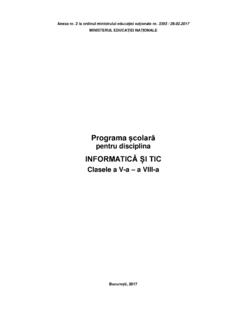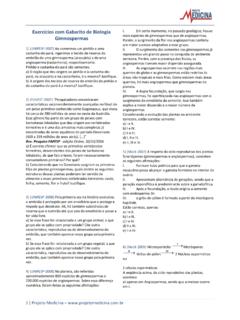Transcription of ANALYSIS OF CYCLONE COLLECTION EFFICIENCY
1 ANALYSIS OF CYCLONE COLLECTION EFFICIENCY . Simona Lizica PARASCHIV+, Spiru PARASCHIV+. +. DUNAREA DE JOS UNIVERSITY, Galati, Romania. Rezumat. Separatorul centrifugal (ciclonul) se distinge prin simplitate constructiv , eficien ridicat , siguran . n exploatare, cost redus de intre inere i func ionare fiind printre cele mai adecvate i utilizate separatoare de praf din aplica iile industriale. Studiile tiin ifice demonstreaz faptul c eficien a ciclonului depinde de dimensiunea particulelor separate, viteza gazului la admisie i densitatea particulelor. Scopul acestei lucr ri este de a ar ta influen a dimensiunii particulelor i a vitezei de intrare a gazului n ciclon asupra eficien ei colect rii. Cuvinte cheie: eficien a ciclonului, densitatea particulelor, diametrul limit al particulelor. Abstract. Cyclones have been considered as one of the simplest type of separator and because of their high EFFICIENCY , adaptability, simple design and low maintenance, construction and operation costs, they are ideal for use in the various industrial applications.
2 The literature indicates that the CYCLONE EFFICIENCY is dependent on the particle size, inlet air velocity and particle density. The objective of this paper is to demonstrate the influence of the particles size and the input velocity of the gas into the CYCLONE over the COLLECTION EFFICIENCY . Keywords: CYCLONE COLLECTION EFFICIENCY , particle density, cut-off diameter. 1. INTRODUCTION the operation is generally simple and requires no maintenance. The separation of solid particles is required in Their low capital cost and free maintenance many industrial processes because of growing operation makes them ideal for use as pre-cleaners concern for the environmental effects of particulate for more efficient final control devices such as pollution. electrostatic precipitators. CYCLONE separators has a cutoff aerodynamic diameter greater than 5 to 10 m and therefore it is 2.
3 BASICS OF CYCLONE SEPARATORS. often used as common devices for pre-cleaning gas in front of other high EFFICIENCY devices. CYCLONE separators are gas cleaning devices Selecting a particulate emissions control system that use the centrifugal force of a gas stream. The is generally based on knowledge of four elements: gas flow due tangential entry is forced to follow particle concentration in the stream to be cleaned, the curved geometry of the CYCLONE while the particles size distribution, the flow gas rate and inertia of particles in the flow causes them to move final allowable particulate emission rate. towards the outer wall, where they collide and Although cyclones were traditionally regarded collect. as relatively low EFFICIENCY collectors at present In a CYCLONE the particles from the spinning gas they can achieve efficiencies of 90% for particles stream move progressively closer to the outer wall larger than 15 to 20 m.
4 And execute several complete rotations as they A CYCLONE separator is a device that separates flow through the device. particles from a gas stream using centrifugal force. This type of CYCLONE is used frequently as a pre- By this method, it is possible to separate the larger cleaner to remove fly ash and large particles and its particles from the gas. main advantages are low pressure drop and high The cyclones may be constructed of any volumetric flow rates. material (metal or ceramic) that is capable of The CYCLONE separates solid particles from a gas, withstanding the abrasive particles, high based on the principle of centrifugal force, which temperatures and corrosive environments. It is is much stronger than gravitational force. It works necessary that the inner surface be smooth so that more efficiently at high gas flow rates, because a the collected particles can easily slip down the wall large velocity creates a swirling movement inside into the bunker.
5 CYCLONE has no moving parts so the column. 108 TERMOTEHNICA Supliment 1/2016. ANALYSIS OF CYCLONE COLLECTION EFFICIENCY . The basic principle of CYCLONE is to force the The discharge orifice is located at the end of particles laden gas in a vortex, where inertia and conical section and its diameter is determined by gravitational forces affect particle separation. the application involved and must be large enough In this device, the fluid enters tangentially into to permit the solids that have been classified to the cylindrical chamber and the flow descends underflow to exit the CYCLONE without plugging. rotating near the wall, until the vortex end position where the axial velocity component reverses itself, 3. COLLECTION EFFICIENCY OF. thus making the flow to ascend. The ascension CCYCLONE SEPARATORS. proceeds near the CYCLONE axis and is formed a The capacity of the CYCLONE to collect particles double vortex structure, as indicated in the figure.
6 Is measured by its EFFICIENCY , defined as the fraction of the inlet flow of solids separated in the CYCLONE . Since a CYCLONE typically collects a wide range of particle sizes, it is common to work also with different efficiencies, each defined for a particular and limited range of particle sizes. It is also evident that very large particles will be always separated, while the very fine material will always escape. The cutoff diameter is defined as the particle diameter corresponding to 50% CYCLONE COLLECTION EFFICIENCY . Because of the turbulent flow in the CYCLONE separator the particle concentration is assumed to be uniform and their removal occurs in a thin layer at the outer wall. Fig. 1. Sketch of the two flow patterns in a reversed-flow The COLLECTION EFFICIENCY of a CYCLONE that has cyclon an angle T f is: The inner vortex will lead the flow out through 2vr2 r 2T f.
7 K 1 exp . vT2 r r . a central duct, called the vortex finder. The vortex 2 2. finder goes into the CYCLONE body and protects the 2 1. inner vortex from the high inlet velocity and The two velocity components, axial velocity stabilizes it. and radial velocity are: The solid particles which are denser than the - axial velocity : gas, have a high centrifugal force, which directs Q. vT2. them to the walls, where they collide and lose Wr2 ln r2 / r1 momentum so become disengaged from the flow. - radial velocity : The separated solids slide on the conical wall and U p Q 2 Dp2. are collected at the lower part. vr2. 18P r23W 2 ln r2 / r1 2. The main part of the CYCLONE is the cylindrical feed chamber whose function is to extend the The COLLECTION EFFICIENCY in terms of the CYCLONE length to increase the retention time. physical variables of the CYCLONE is: Another important parameter is the inlet nozzle U p QDp2T f.
8 Area in the feeding chamber which is normally a K 1 exp . 9 P r2W r2 r1 ln r2 / r1 . 2 2. rectangular orifice. The next important parameter is the vortex where: is the EFFICIENCY of the CYCLONE ; Dp - finder whose main function is to control both the dimensions of particles, m; r2 - inner radius of separation process and flow leaving the CYCLONE . cylindrical body; r1 - outer diameter of central tube;. Vortex finder size is about times of the p particle density; - gas mixture viscosity; Q - CYCLONE diameter and it is sufficiently extended as gas flow rate, m3/s. to prevent the entry of supplying material directly Figure 2 shows the COLLECTION efficiencies for into the overflow. the CYCLONE analyzed and we can see that the For the basic CYCLONE , its length should be relation predict an asymptotic approach to 100% of its diameter. The conical section has an complete COLLECTION with increasing particle angle between 10o and 20 o and has a similar role diameter.
9 The separation EFFICIENCY increases with with cylinder section to increase retention time. the increasing of particle size. TERMOTEHNICA 1/2010 109. Simona Lizica PARASCHIV, Spiru PARASCHIV. 1. EFFICIENCY [%]. 0. 0 5 10 15 20 25 30. Particle size [Pm]. Fig. 2. Variation of separation EFFICIENCY based on particles diameter 1 1. 3. Up=1 g/cm Up=1,5 g/cm3. d50. p =16 Pm d50=13 Pm p EFFICIENCY [%]. EFFICIENCY [%]. 0 0. 0 5 10 15 20 25 30 0 5 10 15 20 25 30. Particle size [Pm] Particle size [ Pm]. 1. 3. Up=2 g/cm d50. p =11 Pm EFFICIENCY [%]. 0 ]. 0 5 10 15 20 25 30. Particle size [Pm]. Fig. 3. Variation of separation EFFICIENCY based on particles density 110 TERMOTEHNICA Supliment 1/2016. ANALYSIS OF CYCLONE COLLECTION EFFICIENCY . Figure 3 shows the variation of 50% cutoff REFERENCES. diameters for different particle density. We can [1] J.
10 Benitez Process Engineering and design for air observe that the cutoff diameter of the particle is pollution control PTR Pretince Hall, New Jersey, highly influenced by particle density and their (1993). diameter. [2] Heinsohn, Kabel Sources and control of air pollution Prentince Hall, New Jersey, (1995). The graph shows that the lowest 50% cutoff [3] L. Wang, Parnell, Shaw, Lacey - ANALYSIS diameters was obtained to gas mixture viscosity of CYCLONE COLLECTION EFFICIENCY , ASAE, (2003). input of 1 g/cm3 while for a gas mixture [4] G. Lazaroiu Solutii moderne de depoluare a aerului . viscosity input of 2 g/cm3 CYCLONE has reached a Seria Inginerie - Mediu, Editura Agir, Bucuresti, (2006). [5] K. Yetilmezsoy - Determination of Optimum Body 50% cutoff diameter of 11 m. Diameter of Air Cyclones Using a New Empirical Model and a Neural Network Approach, Environmental 3.




